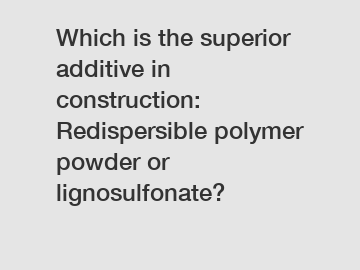Which is the superior additive in construction: Redispersible polymer powder or lignosulfonate?
Which is the superior additive in construction: Redispersible polymer powder or lignosulfonate?
In the construction industry, the choice of additives plays a crucial role in enhancing the performance and durability of building materials. Two popular options that are often considered are redispersible polymer powder and lignosulfonate. Both these additives offer unique properties and benefits, but which one is the superior choice? Let's delve into the characteristics of each additive and compare them to determine their suitability for construction applications.
Redispersible polymer powder, as the name suggests, is a water-redispersible powder obtained by spray-drying a polymer dispersion. It is typically made from a mixture of polymers, including vinyl acetate, ethylene, and acrylics. This additive is commonly used in various construction materials, such as mortars, tile adhesives, and self-leveling compounds. Redispersible polymer powder offers several advantages, which contribute to its popularity in the industry.

Firstly, redispersible polymer powder improves the adhesion strength of construction materials. It forms a flexible and durable polymer film when mixed with water, enhancing the bond between different components. This increased adhesion not only improves the overall strength but also enhances the material's resistance against cracking, impact, and other external forces.
Secondly, redispersible polymer powder provides excellent water resistance. Its hydrophobic nature makes it an ideal additive in areas prone to moisture exposure, such as bathrooms, swimming pools, or external facades. By preventing water penetration, this additive helps to maintain the structural integrity of the materials and reduces the occurrence of issues like efflorescence, mold, and mildew. Additionally, it enhances freeze-thaw resistance, making it suitable for regions with harsh climates.
Thirdly, redispersible polymer powder improves workability and flexibility. Due to its unique properties, it enables easier mixing, spreading, and troweling of construction materials, resulting in reduced labor costs and increased productivity. Additionally, the flexibility it provides allows the materials to withstand movements and minor deformations without cracking, ensuring their longevity.
On the other hand, lignosulfonate, a byproduct of the paper industry, is a water-soluble polymer widely used as an additive in construction applications. It is primarily used as a water-reducing and dispersing agent in concrete and cement applications. Lignosulfonate offers its own set of advantages, which make it a popular choice in the industry.
One of the key benefits of lignosulfonate is its ability to improve the workability of concrete. By dispersing the cement particles and reducing the water content, it enhances the flowability and plasticity of the mix. This results in easier pouring, leveling, and compacting of concrete, making it a favorable choice for construction projects where concrete placement is challenging.
Furthermore, lignosulfonate acts as a water reducer in concrete, improving its strength and durability. By reducing water content and increasing the density of the mix, it enhances the concrete's compressive and flexural strength. This property is particularly advantageous in high-strength concrete applications or projects where concrete with a lower water-to-cement ratio is desired.
When comparing redispersible polymer powder and lignosulfonate, it is important to consider the specific requirements of the construction project at hand. Each additive offers unique benefits that may be more suitable for certain applications.
In conclusion, both redispersible polymer powder and lignosulfonate have their distinct advantages in construction applications. Redispersible polymer powder excels in improving adhesion, water resistance, and workability of materials. On the other hand, lignosulfonate is renowned for its ability to enhance workability and strength of concrete. Ultimately, the choice between these additives depends on the specific needs and desired properties of the construction project.
For more information, please visit Flexible Polymer Powder for Wall Putty, Redispersible polymer powder vs PVA powder, tiling VAE powder manufacturer.
245
0
0

Comments
All Comments (0)